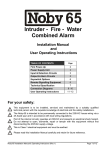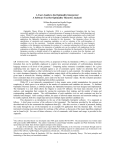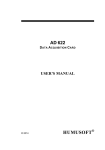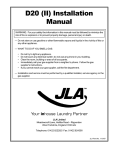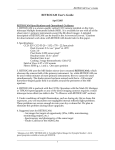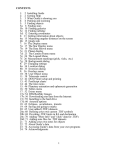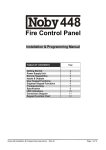Download N220iR2 Installation Manual Rev-1
Transcript
Installation Manual Please read these instructions carefully and retain them in a safe place for future reference. IX-02-151 Noby-220iiR2 Installation Manual - Page 1 - Software Revision1-0 - Contents Page Noby-220iiR2 Overview Installation and Commissioning Location and mounting the Noby-220iiR2 6 Connecting the 230VAC supply 6 First power up 7 Connecting the detectors 7 Connecting the external sounders 7 One-man test 8 Automatic Re-sound Option 8 Input / Output Terminals 9 External Fault Input 9 Fault Output 9 interlink Data Bus 10 interlink Programming 10 LED Strobe / Lamp Output 13 Relay Output 13 Engineer Disablement Options Panel Behaviour 14 15 Audible alarms, faults & warnings 15 Panel Reset 15 LED Lamp and 230VAC Mains Loss Maintenance Troubleshooting Warnings & Cautions Specification User Operation LED Display Indications Noby-220iiR2 Installation Manual - 3 6 Page 2 - 15 15 16 17 18 21 22 Software Revision1-0 - Noby-220iiR2 Overview The Noby-220iiR2 Fire Control Panel is an enhanced version of the standalone Noby-220, fitted with an interlink data bus for connecting up to 8 control panels. Fire Alarms and Fault Warnings are signalled across the interlink bus connection to alert neighbouring properties. Local alarms are audibly signalled with a continuous sounder tone, whilst remotely triggered alarms are differentiated with pulsing sounders. The origin of a fire alarm is identified on the latching LED display at all remotely connected panels. A 60s delay on transmitted fire alarms provides a time window in which to cancel a nuisance false alarm. Silencing the panel-in-alarm will automatically silence all connected panels, provided that no new alarm has been triggered from another panel. Each property owner can silence their own local sounders manually at their panel. All panels will re-sound upon receipt of a new fire alarm. Fire alarm LED indication is latched until a Panel Reset is performed at each individual property. Fault LED indications remain latched at the local property until the panel is reset. Fault conditions originating from remote properties are displayed in real-time at the local panel, and the LED indications are automatically cleared when the remote panel is reset. Audible fault tones are only provided at the local property. The Noby-220iiR2 control panel is fully monitored according to EN54-2 and EN54-4 standards, and the interlink data connection is securely monitored for physical disconnection and/or data errors. Noby-220iiR2 Installation Manual - Page 3 - Software Revision1-0 - Figure 1: Detector and Sounder Circuits Noby-220iiR2 Installation Manual - Page 4 - Software Revision1-0 - Figure 2: Internal Layout Noby-220iiR2 Installation Manual - Page 5 - Software Revision1-0 - Installation and Commissioning This equipment is to be installed, serviced and maintained by a suitably qualified technical person with the requisite knowledge of electrical and fire safety installations. Location and Mounting It is best to locate the Noby-220iiR2 in a public space, e.g. a hallway or landing area, where the LED Strobe/Lamp is visible and the internal alarm sounder can be clearly heard. Another consideration is to position the panel to make most effective use of the LED Strobe/Lamp, which switches on automatically in the event of mains power loss. The Noby-220iiR2 is intended for indoor use only, and must be sited in a dry environment. Do not site the Noby-220iiR2 outside, or in any location where it may become exposed to damp or freezing conditions. All components are selected to operate within their specification when the environmental conditions outside the enclosure comply with class 3k5 of EN60721-3-3:1995; temperature range -5°C to +40°C; 95%RH. The enclosure is rated at IP30, which offers protection against tools and wires greater than 2.5mm width, but no protection against liquids. Mount the Noby-220iiR2 securely onto a flat solid surface at the three fixing points denoted by ‘MH’ in Figure-2, using wall fixings appropriate for the material. In some situations it may be desirable to recess the panel into a hollow section wall, in which case the ‘Noby-220iiR2 Flush Mounting Kit’ provides the necessary fixing harness and stainless steel frame. Connecting the 230VAC supply Connect the 230VAC to the Noby-220iiR2, paying strict attention to local wiring regulations. A readily accessible disconnect device shall be incorporated into the building installation wiring. Feed the cable securely through the rear cable-entry hole CE2, or via a 20mm cable-gland CG4. Alternatively a 3-core 230VAC flexible cord can be fed through CG5 (top) or CG6 (bottom) using the strain relief bush supplied (suitable for cable diameters 6.2mm to 7.4mm). In this case ensure that the cord is connected to the building installation wiring via a readily accessible disconnect device fitted with a 2A fuse. Strip back the outer sheath of the cable 25mm and then strip back each inner core 6mm, such that the cable double insulation is preserved inside the enclosure to within 25mm of the screw terminals. The Noby-220iiR2 is Class-1 equipment and shall be earthed. Connect the earth core of the incoming cable to the earth point on the enclosure. Consult a qualified electrician if there are doubts concerning electrical safety. Noby-220iiR2 Installation Manual - Page 6 - Software Revision1-0 - First power up It is recommended that the Noby-220iiR2 is first powered up with the End Of Line devices still connected to the screw terminal block at the panel, as supplied from the factory. This will help to establish that the panel is functioning OK before connecting any external devices. • • • • • • • • • • Switch off or disconnect the 230VAC supply. Position the battery as shown in Figure-2, with the -'ve terminal to the rear of the enclosure. Connect the battery terminals, observing strict battery polarity. Press the pushbutton marked “Batt Start”. The panel powers up indicating a PSU fault, accompanied by a fault tone (2 beeps every 4s). The LED Strobe Lamp is automatically activated due to there being no 230VAC at this time. Switch on the 230VAC supply to the panel. The green Power LED blinks (occults) every 4 secs, indicating that 230VAC has been absent (memory). Perform a Panel Reset (refer to User Operation on page 21). The Noby-220iiR2 should now be in standby mode with a steady green Power LED and blue backlight. Connecting the detectors (Figure 1) • • • • • • • • Up to a maximum of 10 detectors can be connected to each zone. Up to a maximum of 10 call-points can be connected to each zone. Ensure that the detectors are within specification to operate at 10.5 volts. Use detector bases fitted with a schottky diode. Connect the detectors and call-points in a straight daisy-chain manner, with no spurs or loops. The recommended maximum cable length on each circuit is 100m. Maintain strict polarity from the panel, and from one detector to the next. Remove & re-connect the factory fitted EOLC at the outermost detector base. Connecting the external sounders (Figure 1) • The total combined sounder circuit current available across both circuits, is 150mA. e.g. up to 10 sounders can be connected with a current draw of 15mA each. • The sounders must compatible with conventional fault monitoring (polarised). • Ensure that the sounders are within specification to operate at 10.5 volts. • Connect the sounders in a straight daisy-chain manner, with no spurs or loops. • The recommended maximum sounder cable length is 100m per loop. • Maintain strict polarity from the panel, and from one sounder to the next. • Remove & re-connect the factory fitted EOLR at the outermost sounder. Noby-220iiR2 Installation Manual - Page 7 - Software Revision1-0 - One-man test The one-man test is a test facility to aid commissioning and testing of the system, allowing the installer to walk-test the system and trigger each detection device in turn. • Enter the Engineer Access Code-2 1 • Press either and/or followed by . 2 to toggle on/off the desired zone/s for testing. • The selected zone/s are indicated by rotating LED patterns on the corresponding pushbutton/s. • You now have 90s to trigger the first device, and 90s thereafter to trigger the next device. • Each triggered device will pulse the sounders and flash the red zone LEDs until the test alarm condition is clear. The panel automatically resets the detectors. Note that the relay output remains unaffected by the one-man test mode. • Press to exit the one-man test mode. Note: The panel automatically kicks back to normal standby User Mode after 90s of no activity, or if there is a real fire condition detected on a zone not being tested. Automatic Re-sound – Programmable Option It is a requirement of EN54-4 that it must be possible to configure the fire panel to automatically re-sound following an alarm in another zone. This is the default factory setting for the Noby-220iiR2. The panel can be reconfigured to automatically re-sound following an alarm only in the same zone by clearing the option switch. From normal standby User Mode enter the following key sequence: Engineer Access Code-1 1 2 1 2 Select Toggle 1 2 2 Auto Re-sound Option LEDs Off= No Auto Re-sound LEDs On= Auto Re-sound* * Factory default setting • The green Power LED flashes rapidly upon successfully entering the Engineer Access Code-1. • The LEDs surrounding button • Toggle button • Press 2 to set/unset the desired option. to accept OR press Noby-220iiR2 Installation Manual - 2 indicate the current option status. to quit without updating the option. Page 8 - Software Revision1-0 - Input / Output Terminals Figure 3: Input / Output Terminal Strip External Fault Input (Terminal 1) The Fault Input terminal permits a fault signal from external equipment to be indicated on the Noby-220iiR2 control panel. The LED indication is non-latching i.e. the LED follows the Ext. Fault Input status. The polarity of the input is programmable. The factory setting is for a +12V signal to be applied to the terminal to bring up a fault indication. Note that connecting external equipment also requires a ground reference connection i.e. 0V from the external equipment must be connected to 0V on the Noby-220iiR2 (Terminal 4). From normal standby User Mode enter the following key sequence: Engineer Access Code-1 1 2 2 1 Select Toggle 1 1 2 Fault Input Polarity Option LEDs Off= +12V applied* LEDs On= +12V removed * Factory default setting • The green Power LED flashes rapidly upon successfully entering the Engineer Access Code-1. • The LEDs surrounding button • Toggle button 1 • Press 1 indicate the current option status. to set/unset the desired option. to accept OR press to quit without updating the option. Fault Output (Terminal 2) A 12V/20ma open-collector output signal. Normally high (12V), it falls to 0V upon detection of any fault originating at the local panel only i.e. does not include the Ext. Fault Input, interlink bus faults, or any fault originating at a remote panel. Note that connecting external equipment also requires a ground reference connection i.e. 0V on the Noby-220iiR2 (Terminal 4) must be connected to 0V on the external equipment. Noby-220iiR2 Installation Manual - Page 9 - Software Revision1-0 - interlink data bus (Terminal 3) The interlink data bus has been laboratory tested with up to 1km of standard low-grade alarm cable (92mohm/m 160pF/m), connected in different configurations i.e. linear, star, clustered etc.. These tests were conducted in a simulated electrically noisy environment, but we appreciate that real world installations can be more harsh and varied. We therefore specify that the maximum installed interlink cable length is 250m, which provides a four fold safety margin. Installations exceeding 250m are not guaranteed by Noby UK and are undertaken at the installer's risk. The overiding limiting factor is that the total installed cable capacitance must not exceed 100nF i.e. the pF/m multiplied by the total length of cable used. Also, the total circuit resistance must not exceed 100ohms (or 50ohms per leg). Wherever possible avoid running the cable in close proximity to transmitter devices, or in conduits containing potentially noisy electrical cables. Screened cable may provide some immunity in excessively noisy environments (e.g. near RF transmitters etc.) - with the screen connected to a good clean earth at one point only on the system. The data connection is low speed and there is little advantage to be gained in using more expensive high speed data cable, although national regulations might stipulate the use of flame retardant cable. The protocol is fail safe, meaning that in the event of a cable burn-out all remote panels will continue performing according to the last signal received, and at the very least they will continue to function as standalone fire control panels. If this is your first Noby-220iiR2 installation then it is highly recommended to familiarise yourself with the system and program the addresses on the work bench, rather than on site with the panels distributed across 8 properties. interlink Programming As supplied from the factory the i nterlink is disabled and the Noby-220iiR2 defaults to offline, acting as a single standalone fire control panel. To enable the interlink connection each Noby-220iiR2 panel must be programmed with a UNIQUE address according to the procedure set out below. The addresses can be programmed with the panels online or offline, whichever is the more convenient. Online 'live' programming guarantees that all addresses are unique since the system seeks free address slots. You may start with just one panel, and then add further panels one by one, each time programming the address at the newly added panel. The system allocates the next available address number, such that the address numbers 1 to 8 are programmed according to the order in which the panels are added. Offline (manual) programming requires a more methodical approach, and carries a greater risk of duplicating one or more addresses. The possibility of duplicating addresses exists where panels are either pre-programmed off-site or swapped from another system. The symptoms of a duplicated address are not always immediately obvious, although in most circumstances a Bus Error Fault will be indicated. Noby-220iiR2 Installation Manual - Page 10 - Software Revision1-0 - Figure 4: interlink Programming LED Display LED Indications: A steady green LED indicates that this panel is interlink enabled. A steady red LED indicates that this panel is interlink disabled i.e. no address programmed. The pulsing red LED indicates the programmed address number 1 to 8 of this panel. The 8 yellow pushbutton LEDs indicate the detection of all connected panels on the interlink bus, with this panel's LED rapidly flashing. Procedure: 2 • Enter the interlink Code 1 2 2 . • Allow 5 seconds for scanning - the 8 yellow pushbutton LEDs cycle around. • Press 1 to seek the next available address - indicated by a rapid flashing pushbutton LED. - OR • Press • Press 2 to clear the address and disable this panel's interlink functionality. to accept OR press to quit without updating the option. • Allow 8 seconds for the system to stabilise before proceeding with other panel operations. Note: The panel automatically kicks back to normal standby User Mode after 60s if left unattended. Removing a Noby-220iiR2 panel from the interlink bus A panel may be effectively switched offline by clearing its address as described in the above procedure. Noby-220iiR2 Installation Manual - Page 11 - Software Revision1-0 - interLink Remote Alarm 60s Delay - Programmable Option As supplied from the factory all fire alarms signalled across the interlink data bus are delayed by 60s to help reduce nuisance alarms at connected properties. Engineer Access Code-1 1 2 1 2 Select Toggle 2 2 2 Relay Option LEDs Off= iLink Instant Alarm LEDs On= iLink 60s Alarm Delay* * Factory default setting • The green Power LED flashes rapidly upon successfully entering the Engineer Access Code. • The LEDs surrounding button • Toggle button • Press 2 to set/unset the desired option. to accept OR press Noby-220iiR2 Installation Manual - 2 indicate the current option status. to quit without updating the option. Page 12 - Software Revision1-0 - LED Strobe / Lamp Output (Terminal 5) An external LED Strobe/Lamp can be connected between Terminal 3 (anode +'ve) and Terminal 4 (cathode -'ve). This 12V open-collector output mimics the internal LED Strobe/Lamp and is current limited to 20mA with an on-board 220ohm resistor. Relay Output (Terminal 6,7,8) - Programmable Option As supplied from the factory the relay operates as a Fire Alarm relay, but it can alternatively be programmed to operate as a Fault Output Relay by keying the following sequence: Engineer Access Code-1 1 2 2 1 Select Toggle 2 1 2 Relay Option LEDs Off= Fire Alarm Relay* LEDs On= Fault Relay * Factory default setting Note that when programmed as a Fault Output the relay is normally in a de-energised state in order to conserve standby battery power. Total power loss will therefore not be signalled to external equipment. • The green Power LED flashes rapidly upon successfully entering the Engineer Access Code. • The LEDs surrounding button • Toggle button • Press 1 indicate the current option status. to set/unset the desired option. to accept OR press Noby-220iiR2 Installation Manual - 1 to quit without updating the option. Page 13 - Software Revision1-0 - Engineer Disablement Options The Noby-220iiR2 is supplied as a fully functional fire alarm control panel with comprehensive fault monitoring to meet the requirements of the EN54 standard. The following programmable disablement options are provided as a tool to assist the installer in fault finding, such as compatibility issues with 3rd party detectors and sounders. The installer should be aware that the permanent use of these disablement options may have a bearing on the overall safety and approval status of the system. Any permanent setting of these options is undertaken solely at the risk of the installer. From normal standby User Mode enter one of the following key sequences: Engineer Access Code-2 Select Toggle Disablement Option 1 2 2 1 1 1 Disable all Sounder Circuits (internal 85db sounder also reduced to 65dB) 1 2 2 1 1 2 Disable Alarm Relay 1 2 2 1 1 1 1 Disable Detector S/C Faults (s/c zones => fire condition) 1 2 2 1 1 1 2 Disable Detector Head Removal & O/C Fault Monitoring. 1 2 2 1 1 2 1 Disable Battery Fault Monitoring 1 2 2 1 1 2 2 Disable Sounder Circuit Fault Monitoring • The green Power LED flashes rapidly upon successfully entering the Engineer Access Code. • The LEDs surrounding buttons 1 and 2 indicate the current option status. • LED on = option set; LED off = option cleared (factory default). • Toggle button • Press 1 or button to accept OR press Noby-220iiR2 Installation Manual - 2 as required. to quit without updating the option. Page 14 - Software Revision1-0 - Panel Behaviour Audible alarms, faults & warnings In the event of a fire alarm the internal piezo sounder emits a loud rapid pulsing tone, and the external sounder circuit is activated, together with the fire alarm relay (if it has not been re-programmed as a fault relay). All circuit and system faults are accompanied by a fault tone i.e. a double beep every 4 seconds. A warning tone is signified by a double beep every 60s and is most likely to occur when there is loss of the 230VAC supply or 230VAC Mains Loss condition lasting longer than 90s. Panel Reset A Panel Reset attempts to reset the detector circuits and clear the latched LED indications. All the panel LEDs are lit during the 3 second reset period. Note that a standing fire alarm or fault condition will immediately re-trigger the sounders following a Panel Reset. LED Lamp and Mains Power Loss Under normal circumstances the LED Lamp can be switched on for a self-timed period of 10 minutes, or switched on permanently by means of the [Lamp] button. In the event of a 230VAC power-cut the LED Lamp is automatically activated and self-timed for 60 minutes. The Lamp can be manually re-triggered for a further 60 minute period by pressing the [Lamp] pushbutton. Note that in the interest of conserving battery power it is not possible to switch the LED Lamp on permanently during a power-cut. Also, the blue backlight is automatically disabled to conserve battery power. Maintenance Once installed the Noby-220iiR2 should provide many years reliable service. Routine testing and periodic system maintenance should be undertaken by a competent person and in accordance with local statutory regulations. With the exception of fuse replacement there are no user-serviceable parts inside the enclosure. Although the standby battery is monitored for presence and capacity, it is nevertheless recommended as a preventative measure to replace the battery at 4 year intervals. In the event of a suspected fault with the control panel it is advised to disconnect the external loop wiring and fit EOL resistors/capacitors directly at the control panel screw terminals. In this way it becomes possible to determine whether the control panel itself or some other external factor is causing the fault. The Noby-220iiR2 should be cleaned with a damp cloth. Avoid the use of detergents and solvents because these could react with the inks and plastic parts of the facia. Ensure that water does not enter the enclosure. Noby-220iiR2 Installation Manual - Page 15 - Software Revision1-0 - Troubleshooting The green Power LED is not steady Check that the mains supply is connected and switched on. The panel will not power-up when connecting the battery A requirement of EN54-4 is to electronically disconnect the battery when the voltage deep discharges to 10.5v. When connecting a battery it is therefore necessary to manually kick-start the system by momentarily pressing the pushbutton marked “Batt Start”. If the panel does not start up then check the battery fuse F3 and/or the condition of the battery. The Common Fault LED will not clear Refer to the LED Indications (page 22) to determine the cause of the fault. Ooops, I accidentally connected the battery the wrong way round We've all done it at some time or other! Replace fuse F3 (T1.0A) and try again. A smoke detector generates a fault instead of a fire Some (older) detectors and call-points are not compatible with modern panels equipped with short circuit fault monitoring. One remedy is to connect a resistor in series with each affected detector head - any value in the region of 400 to 1000 ohms is suitable. Some detector bases allow spare terminals for this purpose. Care must be exercised not to inadvertently insert this resistor in series with the main cable run, as this will lead to other erratic behaviour. Another work-around is to set the programmable Engineer Disablement Option: Disable Detector S/C Fault Monitoring. In this case all detector short circuits will be interpreted by the panel as a fire condition. There's a persistent zone fault that can't be cleared Check all the detector heads are both present and securely located to their bases. Check base connections, paying particular attention to correct polarity. Check that the EOLC is fitted across the final detector. Check that the detector bases are of the schottky diode type. Programme the Engineer Disablement Option: Disable Detector Head Removal Monitoring. If this clears the fault then the problem is likely to be related to one or more bad detector base/head connections. Note: setting this option also disables o/c monitoring and is therefore not recommended as a permanent fix - the purpose of the option is to help eliminate one possible cause of a fault. Failing the above suggestions, it's down to the systematic process of elimination ie. relocate the EOLC to the first device and disconnect the remaining detectors, then move onto the second device etc.. Repeat until the fault shows up. There's a persistent sounder fault that can't be cleared Check that the sounders are the polarised type and compatible with conventional fire panel fault monitoring. Check the cable connections at each sounder for correct polarity, and that the EOLR is connected across the final sounder on each circuit. Noby-220iiR2 Installation Manual - Page 16 - Software Revision1-0 - Warnings & Cautions Clean external surfaces with a damp cloth and mild detergent. Do not use abrasives, solvents or polish. Noby UK have taken every reasonable effort to ensure that the stainless steel facia is delivered in pristine condition. Please inspect the facia prior to installing the product as Noby UK cannot accept responsibility for any flaws or scratches incurred during installation. This equipment is to be installed, serviced and maintained by a suitably qualified technical person with the requisite knowledge of electrical and fire safety installations. Take care not to accidentally reverse the battery connections during installation. Fuse F3 offers some protection but there is still a possibility of permanent damage to the electronic circuitry. Such damage is identifiable to Noby UK and is not covered by the warranty. The Noby-220iiR2 shall be permanently connected to the 230VAC building installation wiring via a readily accessible disconnection device and in accordance with local wiring regulations. Part of the internal circuitry operates at 230VAC and presents an electrical shock hazard. Do not attempt to open, dismantle, repair or tamper with this equipment without first disconnecting the mains supply voltage. The Noby-220iiR2 is Class-1 electrical equipment and must be earthed. The Noby-220iiR2 incorporates fault monitoring of all circuits as required by the EN54 standard. It is important that fault indications are investigated at the earliest by a qualified engineer. Failure to do so may result in loss of life. Noby-220iiR2 Installation Manual - Page 17 - Software Revision1-0 - Specification PSU & Battery Supply Voltage Max. Input Current Battery PSU Output Voltage PSU Absolute Max Current Fuses: F1,F2 Sndr 1,2 F3 Battery +'ve Imin Imax.a Imax.b Rimax – Max.Battery Circuit Resistance Max Battery Current Draw Standby Battery Current Standby Battery Time Battery Low Voltage Detection Battery Final Voltage – Auto Disconnect PSU Charger Fault Detection 230VAC Mains Loss Detection Detection Circuits No. of circuits (zones) Max detector current /circuit End-Of-Line Capacitor EOLC Head Removal Monitoring O/C Fault Detection Max Loop Resistance S/C Fault Detection Fire Alarm Detection Sounder Circuits Max. Combined Ext. Sounder Current End-Of-Line Resistors (EOLR) Open Circuit Detection Short Circuit Detection Fire Alarm Relay Internal Panel Sounder Internal Panel Fault Tone Value 230 60 12 13.68 200 500 1.0 8 25 2.5 180 10 >88 11.0 10.5 Yes Yes Unit VAC mA V V mA mA Comment +10% -6% 50Hz/60Hz SLA 12V; 1.2Ah or 1.3Ah +/- 150mV (@ Imax.a) F500mA - quick blow T1.0A - slow blow mA mA ohms mA mA hrs V V Value 2 1mA 10.0 Yes Yes 400 <120 120-1500 Unit ohms ohms ohms Value 150 10 >20 <5 1.0 >85 >65 Unit mA Kohms Kohms Kohms A dB dB uF not specified detection delay 60s<t<120s with 230VAC disconnected with 230VAC fault condition see note below** detection delay 60s<t<120s detection delay 60s<t<120s detection delay 60s<t<120s off delay=90s; on delay=10s Comment e.g. 10 detectors at 100uA /circuit non-polarised requires schottky diode bases Comment @ 12.0V sounder spec. rating SPDT 1A/30V voltage free measured at 3.3m, open field ** 1.2Ah battery derated to 0.8C ≡ 88hrs standby followed by 0.5hrs in alarm with 150mA sounder o/p load. Noby-220iiR2 Installation Manual - Page 18 - Software Revision1-0 - Specification (continued) Bus Capacity Max Cable Length Max Cable Capacitance Max Cable Resistance Value 8 250 100 100 Unit Panels m nF ohms Fault Output Output Voltage Swing Series Output Resistance Value 12 220 Unit V ohms Fault Input Input Voltage Range (max.) Input Resistance Voltage Threshold Value 0-30 100 7 Unit V Kohms V LED Strobe/Lamp Output Output Voltage Swing Series Output Resistance Value 12 220 Unit V ohms Comment open-collector pnp transistor Value 168x150x55 1070 1150 3k5 IP30 Unit mm g g Comment interlink Data Bus Physical Cabinet Dimensions W x H x D Net Weight Gross Weight Environmental Class EN60721-3-3:1995 IP Rating Noby-220iiR2 Installation Manual - Page 19 - Comment standard 2 core alarm cable cable length (m) X capacitance/m 50ohms each leg Comment o/c pnp transistor - normally high Comment excl. battery incl. carton -5°C to +40°C; 95%RH not protected from liquids Software Revision1-0 - 1293 Noby UK Ltd, Unit 1F Mill Fold, Elland Road, Ripponden, Halifax, West Yorkshire, HX6 4DJ, UK. 13 1293-CPR-0385 EN 54-2 :1997 +AC :1999 +A1:2006 EN 54-4 :1997 +AC :1999 +A1:2002 +A2:2006 Optional Functions: Total loss of power supply Test condition Output to fire alarm devices Output to fault warning routing equipment Noby-220iiR2 Installation Manual - Control And Indicating Equipment Power Supply Equipment Page 20 - Software Revision1-0 - Noby-220iiR2 User Operation • The most commonly used functions are accessed by a simple one-touch key operation, whilst other more safety critical functions are accessed via a longer key sequence. • The acceptance of each command is confirmed with an audible double click. • When entering the User Access Code, the green Power LED will flash rapidly for 5 seconds signifying that the panel is ready to accept the Command Key. One-Touch Key Momentary Press Press & Hold for 5 secs Silence Panel Re-sound / Evacuate / Sounder Test activates sounders & relay LED Lamp: On / Off 10min timer if 230VAC OK 60min timer if 230VAC absent LED Lamp permanently on i.e. not self-timed no action Disable Zone-1 self-timed 60mins disabled when Z1 yellow LEDs = on no action Disable Zone-2 self-timed 60mins disabled when Z2 yellow LEDs = on User Access Code Command Key Action Silence Main Sounders 1 1 2 or, if already silenced ... Re-sound / Evacuate / Sounder Test activates sounders & relay 1 1 2 Panel Reset 1 1 2 1 Permanently Disable or Re-enable Zone-1 (Toggle on/off) disabled when Z1 yellow LEDs = on 1 1 2 2 Permanently Disable or Re-enable Zone-2 (Toggle on/off) disabled when Z2 yellow LEDs = on Noby-220iiR2 Installation Manual - Page 21 - Software Revision1-0 - Noby-220iiR2 User Mode LED Display Indications Note: Most LED indications remain latched until the Noby-220iiR2 is Reset. /continued Noby-220iiR2 Installation Manual - Page 22 - Software Revision1-0 - System LEDs - Interpretation LED Label Description Power (green) Common Fire (red) Common Fault (yellow) LED Label Status Interpretation a) b) c) d) 230VAC Mains OK 230VAC Mains Loss 230VAC Mains Restored (memory) Code entered - awaiting a command key steady on off 1 blink / 4s rapid flash a) steady on Local fire on Zone-1 or Zone-2 b) pulsing Fire alarm signalled from a remote panel (the pulse count indicates the address no) a) steady on All local panel zone & sounder circuit faults, Fault I/P, remote panel and interlink bus faults. Accompanied by one or more secondary fault LEDs which identify the specific fault condition. b) 1 flash / 4s c) 2 flash / 4s 230VAC Mains Loss Battery Low Voltage (pending Final Voltage) Description Status Interpretation PSU PSU Fault (yellow) a) b) c) d) 1 flash / 4s 2 flash / 4s 3 flash / 4s 4 flash / 4s 230VAC Mains Loss (real time status) PSU Low Volts (latched memory) PSU Charger Fault Battery O/C, Fuse F3 or Battery Ri-max fault CPU CPU Fault (yellow) a) b) c) d) steady on 1 flash / 4s 2 flash / 4s 3 flash / 4s CPU Fault (loss of comms to display PCB) CPU Watchdog occurred (restarted OK) Programme Memory Checksum Error EEPROM Data Memory Checksum Error Disablement (yellow) steady on All or part of the system is disabled Test (yellow) steady on Test Mode Latched fault conditions are cleared by performing a Panel Reset. A persistent reoccurring fault condition could indicate a pending loss of functionality, which should be investigated by a competent person at the earliest. If in any doubt contact the installation company. Noby-220iiR2 Installation Manual - Page 23 - Software Revision1-0 - interlink No. House No. Contact Name Telephone No. Contact Name Telephone No. 1 2 3 4 5 6 7 8 Installation Company Noby-220iiR2 Installation Manual - Page 24 - Software Revision1-0 -































